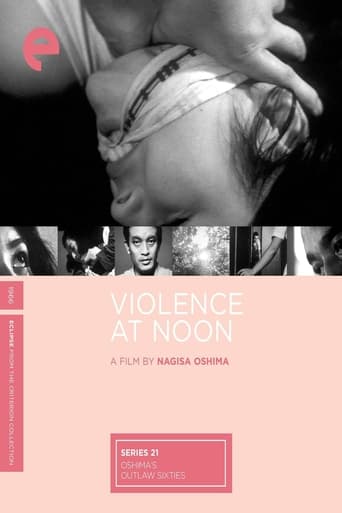mevmijaumau
After Pleasures of the Flesh (1965), Violence at Noon (1966) is the second Nagisa Oshima film to based on a work of literature, this time on Tsutomu Tamura's novel which was in turn inspired by actual crimes that took place in a Japanese rural community. The movie adaptation is a strong stylistic departure from many of Oshima's previous (and subsequent) films.The story itself is very bleak and distressing, but always captivating. It focuses on a few characters with questionable motivations and uncertain fates. Due to being linked with a murdering rapist, their lives take a turn for the worse, casually discussing suicide and pondering on their heavy situation, their philosophy of love seeking no rewards now being put to test. The story is non-linear and characterized by sudden leaps between flashbacks and current time. Despite this, the movie is miraculously easy to follow and never becomes confusing, even if we consider the break-neck editing style which sees over 2000 cuts throughout the duration of the film. It disorients the viewer, but at the same time keeps your attention.The film is inspired by the French nouvelle vague, as made evident by the film's title card which pops up randomly several times during the intro like it's a Godard film. The music is great and the B&W cinematography is fantastic, always finding new ways to focus on the close-ups of Saeda Kawaguchi's gorgeous face and to justaxpose the characters' worried faces with the grayish environment. All in all, a fantastic movie.
TheExpatriate700
Oshima's Violence at Noon is a meditation on the destructive capacity of love. It traces the course of a grotesque love triangle between a rapist and two women who both love him, leading to an ultimately tragic conclusion.This is a deliberately deep, art house film, with much ponderous dialogue. The dialogue serves as much to express Oshima's ideas on love as to advance the plot, with lines such as "Love has no rewards." The film also features some great cinematography, with excellent use of black and white. A sequence in which a violent attack is represented by a series of photographs is a particular highlight.However, the film suffers from a tendency to let ideas take precedence over characterization. We often have little idea why the characters do certain actions, a particular problem given that some of their activities are extreme. Ultimately, this is a thought-provoking film that at times descends into the head scratching.
treywillwest
I really don't know why Oshima's early films have taken so long to become available in the U.S. They are spectacular! I suppose because their thematic content is so specific to the Japan of the post-war "reconstruction" at the hands of the Americans. As radical, contemporary, and at times experimental as Oshima's films from this era were, his landscapes, to my eye, more closely resemble the tradition of Japanese landscape-painting than those of Kurosawa or Mizoguchi. In this film, the past is captured in just such painterly, deep-focus majesty, with dizzying zooms thrown in just to leave you disoriented. The present is soft, blurry, almost indiscernible at times. I'm interpreting the political content of this violent, lude, nasty story to deal with Japan's inability to live up to its WWII atrocities, or from a different perspective, the ease with which it forgave itself. I admit that I don't see how the last scenes fit into that interpretation, but that doesn't make those scenes any less haunting.
zetes
Possibly the most confusing movie I've ever sat through, it took me a long time to get anything out of it. I just couldn't grab onto even the slightest shred of a plot, and, without the ability to find a hook, it felt at first like watching a blank wall. But eventually, I started making inroads and, as the film progresses, its chopped-up plot begins to emerge. It is the story of a rapist and murderer and two women with whom he is intricately involved. Shino is one of his rape victims, and also, we find out, a woman he rescued from suicide in the past. Jinbo is the killer's wife, who knows his guilt (or at least suspects it) but loves him and wants to protect him. Nagisa Oshima actually went to film school in France, and, though part of the Japanese New Wave, no one will miss the French New Wave influences, especially Alain Resnais, whose films have similarly infuriated me in the past with their difficult narratives. Even if I never understood what the hell happened here, the film has several great aspects. The acting is quite good, that's clear. But, in particular, the music, by Hikaru Hayashi, and the cinematography, by Akira Takada, are extremely beautiful. I think I might like this one better if I give it yet another try.ETA: zetes here in the distant year 2010, having just watched the film for the second time. It seems that younger zetes was being a tad dumb, though it could have been the fact that he watched it on a VHS with probably washed-out subtitles (remember those? Yeah, I don't miss them!). The film is actually kind of convoluted, perhaps purposely so. But after the first third of the film, it's fairly clear what's going on. It is quite good, and the visuals and direction are spectacular. This is now available on DVD in an Eclipse box set (it's generally considered to be the best film in that set, too, though I've only watched a couple of films from it so far).


